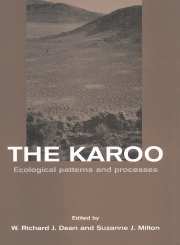Book contents
- Frontmatter
- Contents
- List of contributors
- Foreword
- Preface
- Acknowledgements
- Part one Biogeographic patterns and the driving variables
- Part two Form and function
- 6 Form and function in perennial plants
- 7 Functional aspects of short-lived plants
- 8 Plant reproductive ecology
- 9 Animal form and function
- 10 Animal foraging and food
- Part three Dynamics
- Part four Human impacts
- Part five Comparisons
- References
- Index
6 - Form and function in perennial plants
Published online by Cambridge University Press: 23 December 2009
- Frontmatter
- Contents
- List of contributors
- Foreword
- Preface
- Acknowledgements
- Part one Biogeographic patterns and the driving variables
- Part two Form and function
- 6 Form and function in perennial plants
- 7 Functional aspects of short-lived plants
- 8 Plant reproductive ecology
- 9 Animal form and function
- 10 Animal foraging and food
- Part three Dynamics
- Part four Human impacts
- Part five Comparisons
- References
- Index
Summary
Introduction
The karoo flora contains an astounding variety of growth forms, and its plants range widely in size and shape, type and degree of succulence, leaf consistency and longevity, thorniness, woodiness and below-ground structure. Because environmental stress has strongly influenced selection of plant form in arid systems, it is likely that plant form attributes reveal much about their function. There is no doubt that appropriate growth form classifications are extremely useful in characterizing vegetation at a coarser level than the taxonomic, especially in speciose vegetation. At this stage though, plant growth form classification in arid ecosystems has a tenuous theoretical basis (sometimes as little as intuition alone), limited largely because of ignorance of the consequences of differences between growth form attributes for plant function. A clear understanding of the links between plant form and function is needed to assess the limits to the practical application of the growth form concept. Once established, this knowledge would be useful in identifying important growth form attributes, in understanding the determinants of growth form distribution and even their relative success, and thus in predicting their responses to a changing environment.
Discussion of plant form may be clouded by confusing use of terms. A good example is the apparently interchangeable use of the terms ‘life form’ and ‘growth form’ (Hoffman and Cowling, 1987). Life form is an abstract notion which attempts to capture the essence of the adaptive significance of plant structure. Growth form is concrete, and attempts to typify plants morphologically.
- Type
- Chapter
- Information
- The KarooEcological Patterns and Processes, pp. 91 - 106Publisher: Cambridge University PressPrint publication year: 1999
- 19
- Cited by



